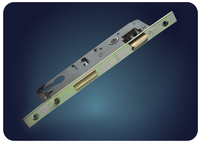Different Types Of Door Hinges
-
There are aspects of home renovation that are exciting and rewarding, after all you are deciding on the surroundings you and your family will be living in for some time to come. But then again, there are also the more mundane details that need to be taken care of. There’s nothing better than the sweet action of a hand forged T Hinge but we know that to most, door hinge manufacturers are like the tyres on a Ferrari, substantially less exciting to discuss than the thing they’re attached to.
Whilst one article is unlikely to turn the general public on to the buzz of a perfectly crafted piece of ironmongery it can at least help with the ‘ins and outs' of the bits in your house that let you out and in. So here is our guide to the specifications and differences between door hinges so you can buy the right ones for the right doors and doorways.
Hinge Styles
door hinges - butt hinge Butt Hinges. These are the most common type of hinge considered to be the most ‘conventional’ of door hinges. They are designed to be sunk in to the door and frame so that when closed only the hinge ‘knuckle’ can be seen. Butt hinges can also be the most heavily engineered of hinges, able to take the weight of heavy oak front doors giving plenty of security (NB for front or back doors we recommend the 4" butt hinge). Ledge and braced doors will not always allow these type of hinges to be fitted but our special small butt hinge will work with our ledge and brace door. A decent pair of 3" butt hinges will be fine to hang one of our internal solid oak doors. Some people want to use 3 hinges per door but this is not really necessary.
door hinges -T Hinges. These are familiar to the country cottage style look. They were designed to fit barn style doors and have a long arm that can attached to either the face or back of the door. The exposed arm makes these door hinges a ‘feature’ rather than being just a functional item. As a rule of thumb, you want the hinge to come out approximately half way across the door so for a 2ft 3 or 2ft 6 door go for a 15" T Hinge. If you've a wider 2 ft 9 or 3ft door then the 18" T Hinge is probably for you.
door hinges - butterfly hinge Butterfly Hinges & H Hinges. These are hinges that fit in a similar way to the Butt Hinge and can be seen as a way of giving a more classic feel to a doorway if T Hinges are unsuitable.
Things To Consider
Door Weight – some of the more traditional ironmongery hinges will be for internal doors. They are designed to be used in pairs whereas other hinges can be used in three’s to share the weight of a heavy oak front door. Don’t forget that wide doors will place relatively more stress on the hinges than narrower doors of the same weight. This is because the further away from the hinge the weight is placed the heavier the load becomes.
Type of Use – Doors that are likely to suffer excessively high usage should be fitted with door hinges that are engineered to take the strain. Something like a stainless steel hinge with ball bearings in the hinge will allow smoother operation for longer.
A Simple checklist...
When choosing your door hinges, run past the following factors first as a checklist...
Internal or External Setting? – Insurance companies will insist on minimum standard hinges for external doors whereas internal doors are lighter and allow much greater choice. External solid oak doors are heavy and require heavy duty hinges for example. The 4" stainless steel butt hinges are perfect for external use.
Type of Door? – does it have a modern or traditional feel and therefore deserves certain styles of hinge to accompany?
Function? – Low, medium or heavy useage?
What type of finish suits the doorway and surroundings? Handmade ironmongery from UK Oak Doors for example comes in an antique beeswax finish rather than a cheap black powder coating available elsewhere.
As a professional window handle manufacturer, we accept all kinds of window hardware orders, welcome to consult.

